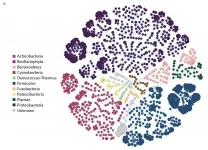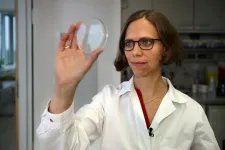Protective ship coatings as an underestimated source of microplastic pollution
Microparticles in the south-eastern North Sea derived mainly from paints and coatings
2021-02-23
(Press-News.org) Shipping traffic can be a major source of tiny plastic particles floating in the sea, especially out in the open ocean. In a paper published in the scientific journal Environmental Science & Technology, a team of German environmental geochemists based at the University of Oldenburg's Institute of Chemistry and Biology of the Marine Environment and led by Dr Barbara Scholz-Boettcher for the first time provides an overview of microplastics mass distribution in the North Sea.
The scientists found that most of the plastic particles in water samples taken from the German Bight, an area in the south-eastern corner of the North Sea which encompasses some of the world's busiest shipping lanes, originate from binders used in marine paints. "Our hypothesis is that ships leave a kind of 'skid mark' in the water which is of similar significance as a source of microplastics as tyre wear particles from cars are on land," Scholz-Boettcher says.
In the autumn of 2016 and 2017, the Oldenburg team took water samples from various locations in the German Bight with the research vessel "Heincke". Scholz-Boettcher and her two colleagues Christopher Dibke and Marten Fischer used stainless steel sieves to filter plastic particles of much less than one millimetre in diameter out of the seawater and then analysed the chemical composition of the collected particles. They used a special analytical method in which the plastic molecules were first heated to temperatures of almost 600 degrees Celsius to break them down into smaller, characteristic fragments, and then separated and assigned to different polymer groups based on their mass and chemical properties.
With this method the researchers were also able to quantify the mass of each plastic type. "Previous studies have only measured particle numbers for the North Sea. We, for the first time, also determined the mass distribution, and thus obtained a more comprehensive picture of the emergence of the different plastic types," Scholz-Boettcher stresses.
The team was surprised by the results: the samples contained above all indicators for polyvinyl chloride (PVC), polymers known as acrylates, and polycarbonates. Their mass accounted for about two-thirds of the total microplastic content in the mean and up to 80 percent in certain samples. Packaging plastics such as polyethylene (PE), polypropylene (PP) and polyethylene terephthalate (PET), which were previously estimated to make up the bulk of microplastics in the sea, accounted for a much smaller percentage. "We weren't expecting this distribution pattern," says Scholz-Boettcher.
When the researchers conducted a more detailed analysis of the results they observed that PE, PP and PET plastics were found mainly near the coastline, whereas in the open North Sea and in the Elbe estuary - particularly in the proximity of major shipping routes - the other types of plastic were predominant. "We believe that these particles originate from ship coatings, where these plastics are used as binders in acrylic paints or epoxy resins, for example," Scholz-Boettcher explains. These results suggest that far larger quantities of microplastics are produced directly at sea than previously thought.
According to the team, literature studies show that in the European Union alone, several thousand tonnes of paint end up in the marine environment every year. With potentially harmful consequences for the environment: coatings and paints used on ships contain heavy metals and other additives that are toxic to many organisms. These antifouling components are used to protect ships' hulls from barnacles and other subaquatic organisms and are constantly rubbed off by the wind and waves. The team is currently conducting further studies, for example in river estuaries and in sediments, to gain more insights into how these microplastics enter the environment.
INFORMATION:
ELSE PRESS RELEASES FROM THIS DATE:
2021-02-23
A recommendation for more intensive blood pressure management from an influential global nonprofit that publishes clinical practice guidelines in kidney disease could, if followed, benefit nearly 25 million Americans, according to an analysis led by researchers at the Johns Hopkins Bloomberg School of Public Health.
The new recommendation from Kidney Disease: Improving Global Outcomes, a global nonprofit that develops evidence-based clinical practice guidelines in kidney disease, is aimed at doctors to help them to reduce blood pressure for chronic kidney disease patients whose systolic blood pressure levels are over 120 mmHg. Blood pressure can be reduced using antihypertensive medications and lifestyle modifications. ...
2021-02-23
Multi-ethnic neighborhoods in England retain their diversity and are much more stable than such neighborhoods in the U.S., according to geographers from the U.S. and U.K. The team examined how neighborhood diversity has changed on a national scale from 1991 to 2011 using U.K. Census data.
Past studies of this kind have often focused on neighborhoods in which the presence of two or three different ethnic groups constituted a diverse neighborhood but this study applied a more rigorous standard. A multi-ethnic neighborhood had to have at least five or more ethnic groups represented and no group could represent more ...
2021-02-23
The cocktail of beneficial bacteria passed from mother to infant through breast milk changes significantly over time and could act like a daily booster shot for infant immunity and metabolism. The research, conducted by scientists from Montreal and Guatemala and published in Frontiers in Microbiology, has important implications for infant development and health.
Researchers discovered a range of microbiome species never before identified in human milk. Until now, relatively little was known about the role microbiome bacteria play in breast milk. These bacteria are thought to protect the infant gastrointestinal tract and improve aspects of long-term health, such as allergy ...
2021-02-23
A toxin produced by bacteria as a defence mechanism causes mutations in target bacteria that could help them survive, according to a study published today in eLife.
The finding suggests that competitive encounters between bacterial cells could have profound consequences on the evolution of bacterial populations.
When bacterial cells come into contact, they often produce toxins as a defence mechanism. Although it is known that the bacteria producing these toxins have a competitive advantage, exactly how the toxins affect the recipient cells is less clear.
"Undergoing intoxication is not always detrimental for cells - there are scenarios in which encountering a toxin could provide a benefit, such as generating antibiotic ...
2021-02-23
To combat climate change, shifting from fossil fuels to clean and sustainable energy sources is imperative. A popular candidate in this regard is hydrogen, an eco-friendly fuel that produces only water when used. However, the efficient methods of hydrogen production are usually not eco-friendly. The eco-friendly alternative of splitting water with sunlight to produce hydrogen is inefficient and suffers from low stability of the photocatalyst (material that facilitates chemical reactions by absorbing light). How does one address the issue of developing a stable and efficient photocatalyst?
In a study recently published in Applied Catalysis B: Environmental, ...
2021-02-23
Having a memory of past events enables us to take smarter decisions about the future. Researchers at the Max-Planck Institute for Dynamics and Self-Organization (MPI-DS) and the Technical University of Munich (TUM) have now identified how the slime mold Physarum polycephalum saves memories - although it has no nervous system.
The ability to store and recover information gives an organism a clear advantage when searching for food or avoiding harmful environments. Traditionally it has been attributed to organisms that have a nervous system.
A new study authored by Mirna Kramar (MPI-DS) and Prof. Karen Alim (TUM and MPI-DS) challenges this view by uncovering the surprising abilities of a highly dynamic, single-celled organism to store and ...
2021-02-23
During ice ages, the global mean sea level falls because large amounts sea water are stored in the form of huge continental glaciers. Until now, mathematical models of the last ice age could not reconcile the height of the sea level and the thickness of the glacier masses: the so-called Missing Ice Problem. With new calculations that take into account crustal, gravitational and rotational perturbation of the solid Earth, an international team of climate researchers has succeeded in resolving the discrepancy, among them Dr. Paolo Stocchi from the Royal Netherlands Institute for Sea Research (NIOZ). The study, now published in the ...
2021-02-23
During this unique study, a team of researchers led by Professor Jane Ogden from the University of Surrey investigated the impact of actively preparing or watching others prepare food (e.g., on a cooking show) versus distraction away from this focus. Researchers sought to understand how this may affect the amount of food consumed and influence the desire to continue eating.
To investigate this further, eighty female participants were recruited and assigned to one of four groups: active food preparation (preparing a cheese wrap within 10 minutes), video food preparation (watching a video of a researcher preparing a cheese wrap), distraction ...
2021-02-23
University of Alberta researchers have found that limiting the amount of fat the body releases into the bloodstream from fat cells during heart failure could help improve outcomes for patients.
In a recent study published in the American Journal of Physiology, Jason Dyck, professor of pediatrics in the Faculty of Medicine & Dentistry and director of the U of A's Cardiovascular Research Centre, found that mice with heart failure that were treated with a drug blocking the release of fat into the bloodstream from fat cells saw less inflammation in the heart and throughout the body, and had better outcomes than a control group.
"Many people believe that, by definition, heart failure is only ...
2021-02-23
New Orleans, LA - An LSU Health New Orleans School of Public Health study reports a positive association between social vulnerability and COVID-19 incidence at the census tract level and recommends that more resources be allocated to socially vulnerable populations to reduce the incidence of COVID-19. The findings are published in Frontiers in Public Health, available END ...
LAST 30 PRESS RELEASES:
[Press-News.org] Protective ship coatings as an underestimated source of microplastic pollution
Microparticles in the south-eastern North Sea derived mainly from paints and coatings




